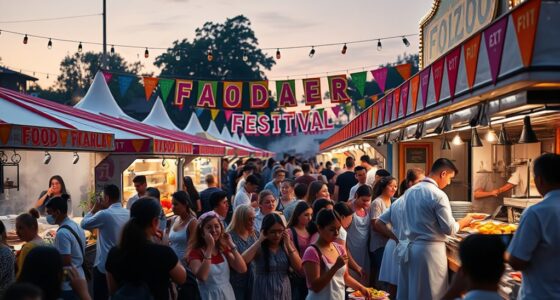Fusion cuisine is all about blending culinary traditions from different cultures to create exciting and flavorful dishes. This culinary style has roots in centuries of trade, migration, and cultural exchange, adding new ingredients, techniques, and flavors to your plate. From Thai-Italian dishes to Japanese-Mexican creations, it reflects history, power, and identity. To discover how these diverse flavors come together harmoniously, explore further—there’s a lot more to uncover about this vibrant culinary trend.
Key Takeaways
- Fusion cuisine combines elements, ingredients, and techniques from different cultures to create innovative and diverse dishes.
- It reflects historical trade, migration, and colonial influences that shaped global culinary exchanges.
- Successful fusion balances authenticity, harmony of flavors, and respect for traditional culinary roots.
- Examples include dishes like Thai Curry Risotto and sushi tacos, blending regional techniques and ingredients.
- Modern trends highlight multicultural dining, emphasizing bold flavors, creativity, and cultural sensitivity.
The Origins and Evolution of Fusion Cuisine
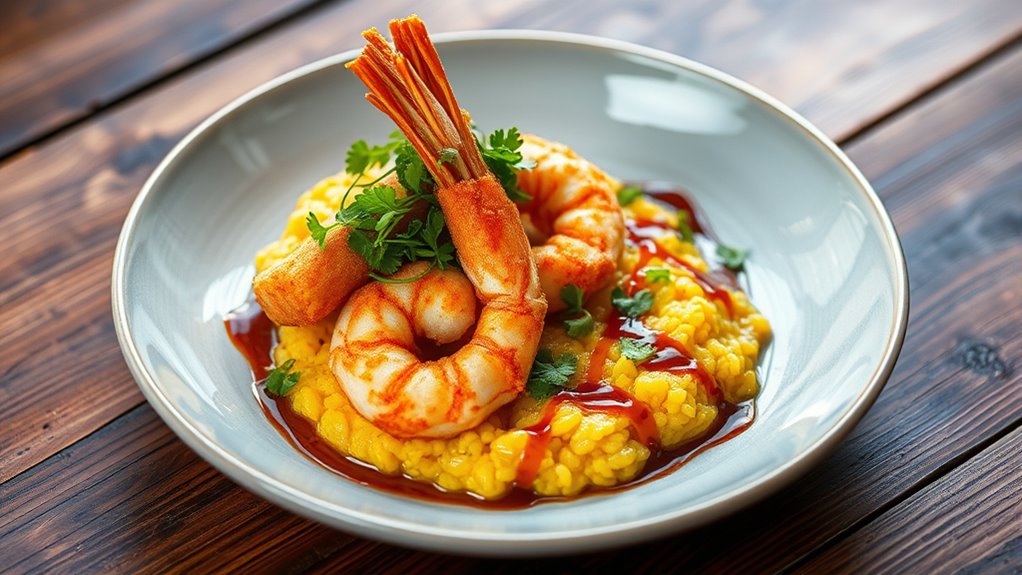
Fusion cuisine has a long history that stretches back centuries, shaped by trade, migration, and cultural exchange. These historical influences introduced new ingredients, techniques, and flavors, transforming traditional dishes. For example, Asian-inspired Italian pasta, like spaghetti, was influenced by Chinese noodles brought through trade routes. Colonialism also played a crucial role, as ingredients and methods from colonized regions, such as bánh mì and Jamaican patties, merged into European and Caribbean cuisines. Indigenous cooks actively contributed by adapting and blending ingredients, despite facing suppression under colonial powers. The cultural significance of fusion lies in its ability to reflect complex histories, power dynamics, and shared identities. It’s a culinary record of how diverse peoples interacted and influenced each other over centuries, shaping the vibrant, hybrid dishes we enjoy today. Trade routes facilitated the exchange of ingredients and cooking techniques, further enriching the cultural tapestry of fusion cuisine.
Key Elements That Define Fusion Dishes
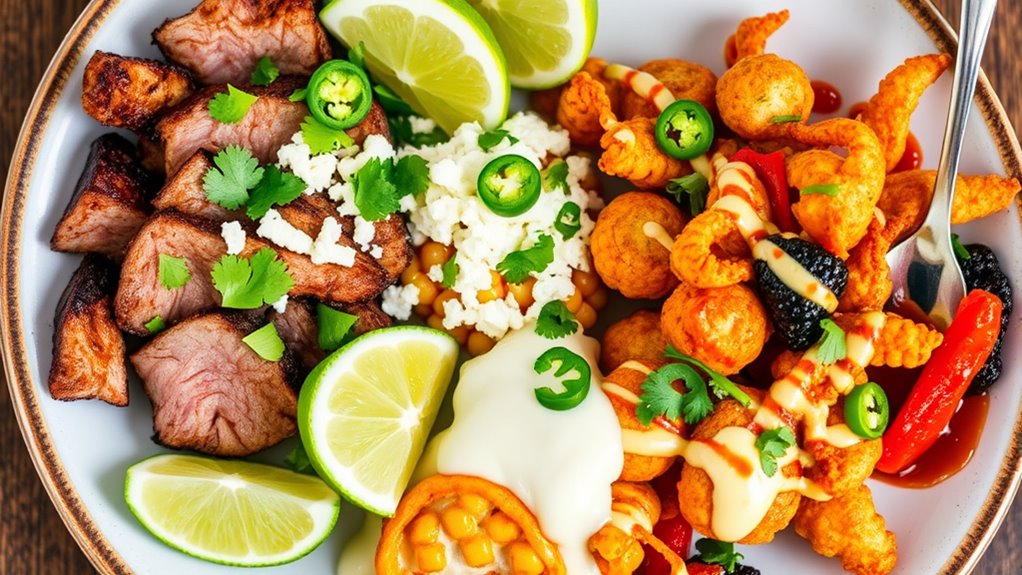
Creating successful fusion dishes requires more than combining ingredients from different cuisines; it demands a thoughtful balance of elements that respect and honor each culinary tradition. The key elements include:
Successful fusion cuisine balances tradition, flavors, and ingredients to celebrate diversity with respect.
- Cultural authenticity – preserving the integrity of base cuisines ensures respect for their origins and prevents cultural insensitivity. Understanding the cultural roots of the cuisines involved helps chefs create authentic and respectful fusion dishes.
- Balance of flavors and textures – achieving harmony among sweet, salty, sour, spicy, and umami flavors, paired with contrasting textures, creates a natural, exciting palate.
- Ingredient harmony – selecting fresh, high-quality ingredients that complement each other, whether through innovative pairings like kimchi with pasta or spices with unexpected dishes, enhances both flavor and respect for tradition.
Mastering these elements allows fusion cuisine to celebrate diversity while maintaining meaningful culinary identities.
Exciting Examples of Culinary Blends Around the World

| Southeast Asian | Thai Curry Risotto, Mango Sticky Rice | Thai & Italian. The fusion of flavors often combines cultural traditions with modern culinary techniques, resulting in unique dining experiences.|
Creative Techniques That Bring Fusion Flavors to Life
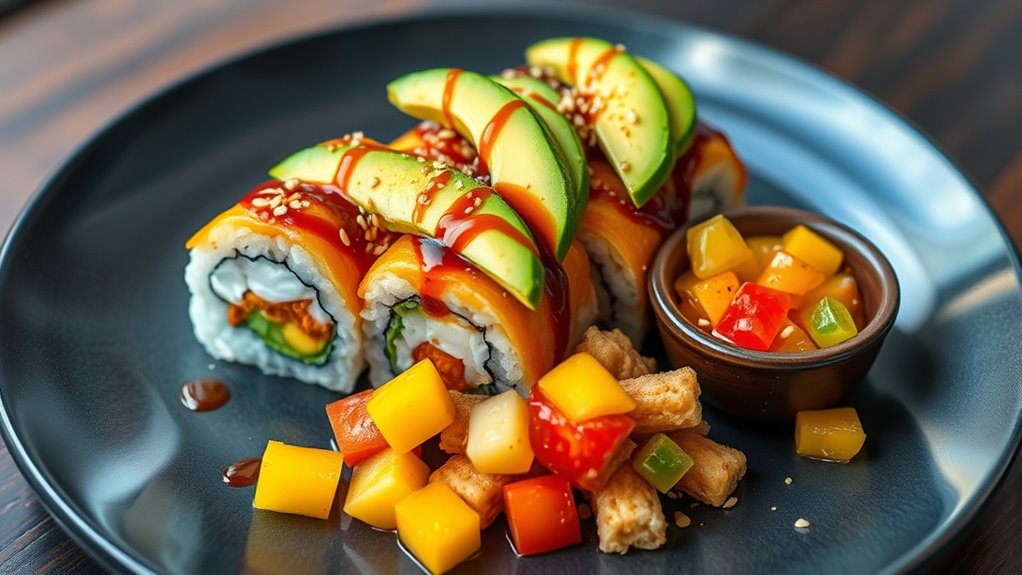
Innovative techniques are essential for transforming traditional ingredients into vibrant fusion dishes. By blending regional influences and reimagining traditional pairings, you can create exciting flavors. To deepen your culinary artistry, consider these methods:
- Apply Chinese wok-frying techniques to Italian ingredients, enhancing texture and flavor. Incorporating cultural culinary methods can lead to more authentic and complex dishes.
- Use French baking methods to craft Asian-inspired desserts, adding sophistication.
- Combine Japanese sushi skills with Mexican fillings, creating bold, new textures. Fusion techniques can be adapted across cuisines to develop distinctive dishes.
These approaches elevate fusion cuisine by respecting cultural nuances while pushing boundaries. Experimenting with different oils, vinegars, and herbs introduces unique aromatic profiles. By understanding regional influences, you craft dishes that are not only visually appealing but also rich in layered flavors. This fusion of techniques and traditions results in memorable, innovative plates that celebrate culinary diversity.
How Fusion Cuisine Is Transforming Modern Dining
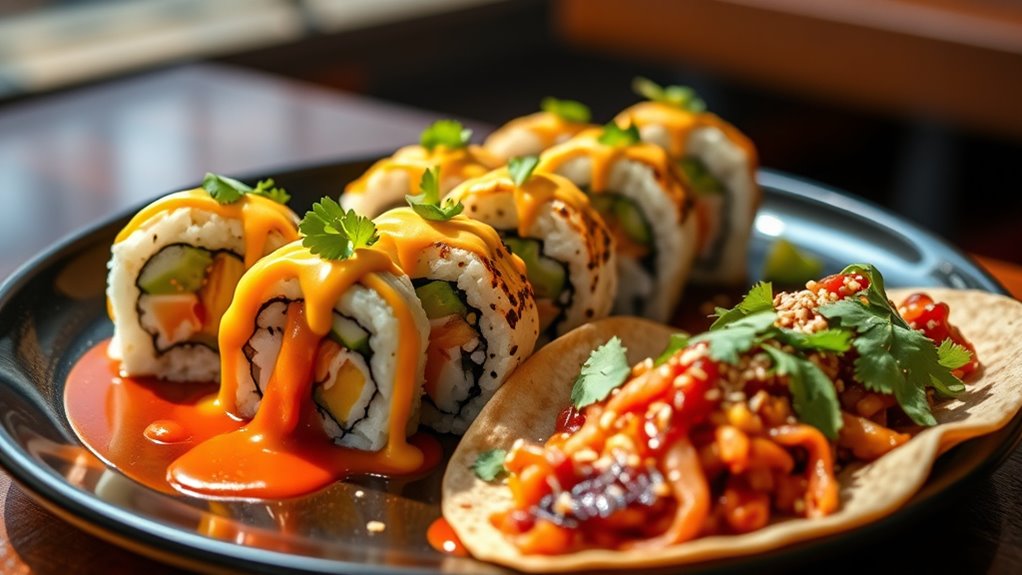
Fusion cuisine is reshaping modern dining by offering guests unique, multicultural flavor experiences that reflect current global interconnectedness. It highlights how cultural identity influences culinary innovation while balancing traditional preservation. This approach appeals to the 64% of consumers seeking diverse experiences, blending bold global flavors with familiar techniques. Restaurants adapt by innovating dishes like sushi burritos or tikka tacos, showcasing cultural exchange. To succeed, they need effective inventory management and cultural sensitivity. Additionally, understanding the importance of affiliate disclosure ensures transparency with customers and fosters trust.
Frequently Asked Questions
How Do Chefs Ensure Authenticity While Creating Fusion Dishes?
You guarantee authenticity in fusion dishes by thoroughly researching each cuisine’s history, ingredients, and techniques. Focus on ingredient sourcing to select high-quality, traditional components, and practice flavor balancing to harmonize diverse flavors without overpowering. Respect cultural narratives and avoid clichés, using genuine methods. Test and refine your recipes through feedback, keeping authenticity at the core while embracing innovative combinations that honor each tradition’s integrity.
Are Fusion Cuisines Suitable for All Dietary Restrictions?
You might wonder if fusion cuisine suits all dietary restrictions. The good news is, it’s highly adaptable. You can find gluten-free options and easily make vegan adaptations by substituting ingredients. Chefs blend diverse elements to cater to various needs, creating inclusive dishes. This flexibility allows you to enjoy flavorful, culturally rich meals that respect your dietary choices, making fusion cuisine a versatile and accommodating option for many dietary restrictions.
What Are Common Mistakes to Avoid in Fusion Cooking?
When you’re exploring fusion cooking, avoid ingredient missteps that can lead to flavor clashes. Don’t rush the process—experiment and tweak recipes to balance flavors and textures. Respect the cultural origins of ingredients and techniques, and don’t overload dishes with incompatible flavors. Listening to feedback helps refine your creations, ensuring harmonious blends. Steer clear of superficial combinations and focus on genuine flavor harmony to create delicious, respectful fusion dishes.
How Does Fusion Cuisine Influence Traditional Culinary Identities?
You might worry that fusion cuisine could threaten cultural preservation, but if you approach it thoughtfully, it can enhance culinary innovation without diluting traditional identities. By respecting core ingredients and techniques, you preserve authenticity while creatively blending flavors. This balance allows you to celebrate cultural diversity, foster cross-cultural appreciation, and keep traditional culinary identities alive. Your mindful fusion practices can promote cultural exchange while maintaining the integrity of traditional cuisines.
Can Fusion Dishes Be Easily Adapted for Home Cooking?
Did you know 85% of home cooks try fusion dishes? You can easily adapt fusion recipes by using ingredient substitution to match what’s available. Focus on flavor balancing to guarantee the combined ingredients complement each other. Be experimental with different techniques and global spices, and start with familiar dishes. With a bit of creativity, you’ll create unique, delicious fusion meals right in your kitchen.
Conclusion
As you savor fusion dishes, remember you’re tasting the modern-day tapestry of global stories—akin to Aeneas’s journey blending worlds. Each bite celebrates cultural exchange, reminding you that, like the mythical phoenix, cuisine continually rises from tradition, reborn in creative harmony. Embrace this culinary voyage, where borders dissolve and flavors unite, transforming your plate into a vibrant mosaic—proof that in the dance of cultures, everyone wins.


